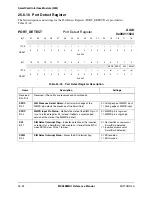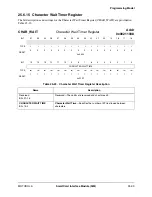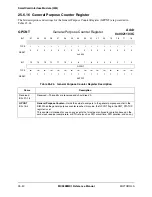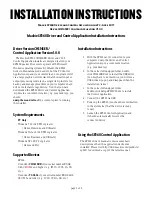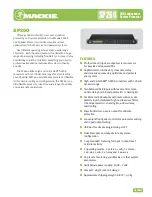
25-42
MC9328MX1 Reference Manual
MOTOROLA
SmartCard Interface Module (SIM)
25.7.2 Configuring the SIM Receiver
Table 25-27 provides the steps to configure the SIM receiver for operation and the cross references for
identifying the specific section for additional reference.
2.
Enable the selected port:
a. Enable power to the SmartCard through the SVEN
bit in the
PORT_CNTL register.
b. Enable SIM transmit data output through the STEN
bit in the
PORT_CNTL register. This is required to allow the SIM receiver to
create NACK pulses.
c. Enable the SmartCard clock through the SCEN
bit in the
PORT_CNTL register.
d. Release the SmartCard reset through the SRST
bit
(assert SRST
high) in the PORT_CNTL register.
Section 25.6.1, “Port Control
Register,” on page 25-22
3.
Select XMT port driver type as open-drain or push-pull through the
OD_P bit in the OD_CONFIG register.
Section 25.6.13, “Open-Drain
Configuration Control Register,” on
page 25-37
4.
Choose the port Baud rate:
a. Select the SmartCard clock rate through the CLK_SEL bits in the
CNTL register.
b. Select the SmartCard baud rate through the BAUD_SEL bits in the
CNTL register.
Note:
Follow the ISO 7816 specification in regard to card clock
frequencies to ensure compliance with the maximum frequency
specification.
Section 25.6.2, “Control Register,”
on page 25-23
5.
Select data format type, or place the SIM receiver in initial character
mode by performing one of the following two steps:
a. Select inverse or direct convention through the IC bit in the CNTL
register.
b. Enable initial character mode through the ICM bit in the CNTL
register.
Section 25.6.2, “Control Register,”
on page 25-23
Table 25-27. Configuring the SIM Receiver
Step
Action
Reference
1.
Enable NACK capability:
a. Select NACK generation on parity errors or invalid initial character
errors through the ANACK bit in the CNTL register.
b. Select NACK generation on overrun conditions through the
ONACK bit in the CNTL register.
Section 25.6.2, “Control Register,”
on page 25-23
2.
Select the desired receive FIFO threshold by programming the RDT
bits in the RCV_THRESHOLD register to the threshold at which the
RDRF flag is set.
Section 25.6.3, “Receive Threshold
Register,” on page 25-25
Table 25-26. Configuring the SIM for Operation (Continued)
Step
Action
Reference
Summary of Contents for DragonBall MC9328MX1
Page 68: ...1 12 MC9328MX1 Reference Manual MOTOROLA Introduction ...
Page 86: ...2 18 MC9328MX1 Reference Manual MOTOROLA Signal Descriptions and Pin Assignments ...
Page 116: ...3 30 MC9328MX1 Reference Manual MOTOROLA Memory Map ...
Page 126: ...4 10 MC9328MX1 Reference Manual MOTOROLA ARM920T Processor ...
Page 160: ...8 8 MC9328MX1 Reference Manual MOTOROLA System Control ...
Page 272: ...13 32 MC9328MX1 Reference Manual MOTOROLA DMA Controller ...
Page 281: ...Programming Model MOTOROLA Watchdog Timer Module 14 9 ...
Page 282: ...14 10 MC9328MX1 Reference Manual MOTOROLA Watchdog Timer Module ...
Page 300: ...15 18 MC9328MX1 Reference Manual MOTOROLA Analog Signal Processor ASP ...
Page 438: ...18 16 MC9328MX1 Reference Manual MOTOROLA Serial Peripheral Interface Modules SPI 1 and SPI 2 ...
Page 478: ...19 40 MC9328MX1 Reference Manual MOTOROLA LCD Controller ...
Page 574: ...21 32 MC9328MX1 Reference Manual MOTOROLA Memory Stick Host Controller MSHC Module ...
Page 598: ...23 16 MC9328MX1 Reference Manual MOTOROLA Real Time Clock RTC ...
Page 670: ...24 72 MC9328MX1 Reference Manual MOTOROLA SDRAM Memory Controller ...
Page 726: ...25 56 MC9328MX1 Reference Manual MOTOROLA SmartCard Interface Module SIM ...
Page 736: ...26 10 MC9328MX1 Reference Manual MOTOROLA General Purpose Timers ...
Page 854: ...29 18 MC9328MX1 Reference Manual MOTOROLA I2C Module ...
Page 900: ...30 46 MC9328MX1 Reference Manual MOTOROLA Synchronous Serial Interface SSI ...
Page 942: ...32 26 MC9328MX1 Reference Manual MOTOROLA GPIO Module and I O Multiplexer IOMUX ...







